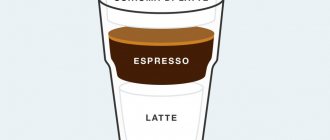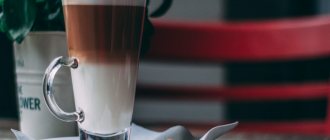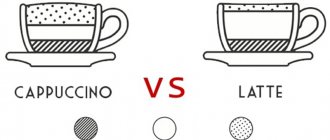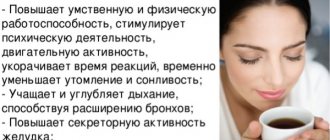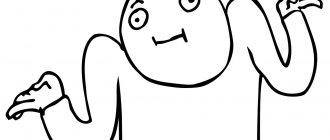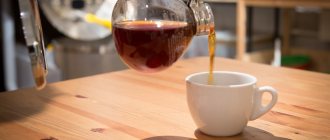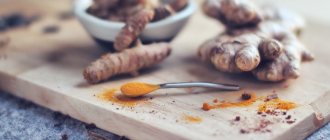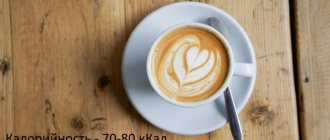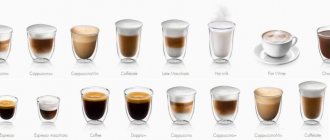Coffee and its unique properties have been known to man for a very long time. Its effect on performance and good mood is known all over the world. Nowadays there are many coffee drinks and cocktails. One of them is coffee latte. He gained a huge number of fans in America and European countries, as his taste and special culture of serving were loved by adults and children. Its composition is very simple - it is whipped hot milk and brewed espresso coffee. “Latte” is translated from Italian as “milk”.
The story of its origin has several versions. Some believe that this drink was invented for baby food, since the latte contains three quarters milk and one quarter coffee. This combination has a minimum of caffeine and does not put stress on the heart. The Italians tell another story, as if one barista added a little coffee to heated milk for flavor, resulting in such a delicate taste. The Austrians and French take credit for the "invention" to themselves. But, no matter who considers himself the first creator of latte, the word is Italian and it sounds with an emphasis on the first syllable.
Currently, thanks to Italian baristas, basic latte recipes have been developed. All coffee shops in the world adhere to their recommendations, both in preparation and in the aesthetics of serving it to customers.
Introduction
Today it is difficult to imagine a cappuccino or latte without a design, even the simplest and most uncomplicated one. It has become a matter of principle for baristas around the world to learn how to pour frothed milk into espresso in a way that turns a cup of delicious drink into a work of art. Thanks to training centers and courses, latte art has taken a separate place in the coffee industry. Annual championships make this trend more and more popular, raising the barista’s quality of work and skill to a new level.
Drawing chocolate flowers on latte
Prepare chilled dairy product. We foam it with the help of a coffee machine, due to the action of a steam engine. Pour milk into tall serving glasses. Take a teaspoon of foam and set it aside.
We brew espresso. To make a cocktail with proportions 1:3. More milk, less coffee. Pour espresso into the frothed milk product.
This needs to be done in the center. If done correctly, a brown spot will form there.
Place the reserved foam on this spot. Using liquid chocolate, we make an outline of the brown spot and a foam outline in the center of this spot. You should get chocolate rings. There are two of them. Now, with the tip of a wooden stick, we begin to draw lines from these rings to the edges of the dishes.
The shapes of the flowers change if lines are drawn from two rings separately. First, draw lines from the coffee stain. Then, the lines from the foam. Or you can combine the lines into one. The video shows this in detail.
History of latte art
Latte art - (from Italian Latte art - “milk” + “art”) is a special way of pouring frothed milk into espresso. Hearts, tulips, rosettes, the use of dyes - all these are components of one incredibly interesting direction. And where, if not in Italy, the birthplace of the espresso machine and cappuccino, could the first drawing appear?
Now it’s impossible to know who was the first barista to decorate coffee with a pattern, but it definitely made an impression on everyone without exception. It was so new, interesting and unusual that it became a matter of time before latte art spread beyond Italy. The main driver behind the popularization of patterns on the surface of coffee was the author of the book “Espresso Coffee. A Guide for Professionals and Espresso Vivace founder David Schomer . Having written many articles and created his own barista school, where a certain place was occupied by the creation of drawings on coffee in various ways, Shomer gave a strong impetus not only to latte art, but also to the development of coffee culture in general. Thanks to him, coffee is now painted on in many countries.
During latte art's journey around the world, the technique was improved, baristas delved deeper into the process, studying the chemical changes in milk when interacting with espresso. Every year, professionals complicate their drawings, adding new elements, and, competing, prove who is the best. Anyone, with a little effort, imagination and desire, can learn how to decorate coffee to delight themselves and their guests. After all, the work of a barista is not only about high-quality execution of menu items, but also about positive emotions, a good mood and a guest’s smile, which is the main motivator and a sign of quality for a coffee shop.
Simple latte art techniques
Portraits of celebrities, classic paintings, three-dimensional figurines of cats - all this can be done if you have developed skills. And beginners should focus on the three most popular options - heart, apple and fern.
Fern technique
Latte art fern
- Movements from the edge of the cup towards yourself. Make the bottom of the branch. The cup stands motionless on the table.
- Make a snake, moving your hand towards you.
- With a reverse movement, that is, away from you towards the edge of the cup, cross out the image with the spout of the jug.
Apple
Latte art apple
- On the opposite side of the cup, carefully form two petals on the petiole of the apple.
- Move your hand to the center of the cup, forming a circle that does not reach the edges.
Main directions
There are two main directions of latte art - “pitching” and “etching” .
Pitching or freepour is the most popular way of painting on coffee. The pattern is created by the pitcher by pouring frothed milk into a cup of espresso.
Etching - drawing on the surface of coffee using additional objects (toothpick, latte art pan, etc.)
Both of these areas are of equal importance and are rated equally by judges at latte art championships. The main and basic elements, no matter whether it is pitching or etching, are the heart, rosette and apple. By combining them together and showing imagination, baristas paint truly mesmerizing pictures.
Pattern with a heart on milk foam
- Foam the milk.
- We brew espresso.
- Sprinkle cocoa onto the foam.
Now we wrap our hand around the pitcher and tilt it over the dish where the drink is ready. Pour in the frothed milk. We hold the vessel over a cup, with a height of about 5 cm. Pour the milk in the center. A white circle has formed.
Now we transfer the spout of the vessel to the place where the heart should have a cavity. We approach the coffee with our nose, approximately to a height of 2 cm, and quickly cross out the milk circle in diameter.
We grab the supposed depression and the sharp tip of the heart. All. The drawing is finished.
Thanks to the sharp drawing of the line, the drawing will be tightened to the last drop and the circle will turn out with a depression on one side and a sharp tip on the other. It's clearly visible in the video.
Just a drawing?
Does drawing on coffee provide anything besides aesthetic pleasure or is it just a drawing? Does its quality and complexity affect the overall perception of coffee? The debate among baristas about the importance of latte art is quite lively. On one side, “latte art is not important, the main thing is taste,” and on the other, “beautiful is delicious.” There are no those who are right and those who are wrong. Why can’t it be both tasty and beautiful?
Based on our experience, we can say that just by looking at the picture you can tell how well and correctly the milk is frothed, whether the espresso recipe is well set up, and how professional and passionate the barista is about his work. For example, problems with milk will appear on both the dark and white parts of the picture. This is especially true for the white part, while problems with espresso will only be noticeable on the dark part.
The first impression sets the tone for the overall perception, because we always “meet people by their clothes.” In the modern, actively competitive world of coffee shops, the visual component of the drink plays a huge role. Social networks (especially Instagram) are a promotion tool and a way to attract and interest new guests. And latte art is a great helper in this. A beautiful contrasting pattern subconsciously adds loyalty points even to the taste of the drink. Provided that this is really high-quality latte art. Let us give you an example: which of the two cups would you like to try? Which one are you more confident of good quality? Without a doubt, one that arouses interest and attracts attention.
Latte and cappuccino: what's the difference?
Another popular milk drink is cappuccino. How does a latte differ from a cappuccino?
— They have different proportional composition. There is half as much milk in a cappuccino, and the cappuccino itself is considered stronger.
— The cooking technology is different. To make a cappuccino, first brew the coffee and then pour in the steamed, heated milk.
- Different foam densities. In cappuccino it is smooth like gloss and harder. If you put a piece of sugar on the foam, the coffee will not change its appearance and the structure will not be disrupted.
— Cappuccino is served in special cups and saucers with a volume of 140 ml. They are usually made of porcelain and have thicker walls to keep the coffee warm longer.
Latte coffee is often called "latte macchiato", which means "stained milk". This name comes from its appearance, as coffee stains are visible on the foam. In fact, a latte with “beautiful” layers is a macchiato. It may differ in proportions: for example, Italians prefer a strong drink made from two parts coffee and one part milk.
In other European countries, a creamy macchiato is popular, containing 1 part coffee and 1.5 parts milk with cream.
In Australia, macchiato is called "picolo latte", which translates as "little milk". It contains coffee half and half with milk.
Some coffee shops offer ghetto lattes or bottle lattes. Customers receive all the ingredients in bottles and mix them according to their taste and desire. Lovers of coffee drinks highly appreciated cocktails made from lattes with the addition of nuts, chocolate, ice cream and syrups. As holiday cocktails, the drink is served with the addition of alcohol: it can be rum or liqueur. It is not recommended to add citrus syrups, as the milk may turn sour.
Latte is a coffee drink with a large amount of milk and contains a minimal amount of caffeine. Therefore, it is useful for any person, including: children, elderly people, pregnant women. Latte has its own mode of consumption: drink coffee with milk in the morning. They do not drink food with it, with the exception of breakfast. This drink is a complete food product containing beneficial substances necessary for the body. It is a powerful antidepressant, stimulates mental activity, invigorates and creates a good mood for the whole day.
You can make latte coffee yourself (at home).
What about the taste itself?
Can the design in a cup affect the taste of coffee? Definitely capable. And what’s most interesting is that with the same amount and ratio (espresso-milk-foam), coffee without a pattern will feel more balanced than the same coffee, but with a pattern. Latte art has a significant impact on the taste of the first sip. The larger the pattern on the surface of the coffee, the milkier it feels. This is perfectly demonstrated by a drawing such as a “heart”. Its size is easy to control by adjusting and playing with the balance of the first sip.
And of course, we shouldn’t forget about the subjectivity of taste. Our brain is capable of producing truly inexplicable things; our taste can change simply according to our mood. And even a definitely not tasty cappuccino with an uplifting beautiful design will seem to you the best you have ever tried.
What is latte coffee: composition
Ingredients of a coffee latte: frothed milk and coffee.
Milk must have a fat content of more than three percent, otherwise it will be difficult to get foam. To one part coffee there are three parts milk. Making a latte requires some skill and skill to create a multi-layered cocktail. The heated milk is whipped (about 70 degrees) until a “fluffy” foam is obtained, and then the coffee is carefully poured into the milk. Thanks to this technology, coffee takes on the appearance of a “zebra” with an elegant alternation of layers. It looks like this: there is foam on top, underneath there is a brown layer of coffee and the most voluminous one is the bottom layer, which consists of milk.
To make this “beauty” visible, the drink is served in tall transparent glasses made of heat-resistant glass. They have a thickened bottom, and the shape resembles an inverted truncated cone. To keep the coffee hot longer, glasses are placed on coasters. Also, for lattes in modern bars, heat-resistant Irish glass glasses with a capacity of 300 ml are used. Special spoons are served along with the glasses.
Making coffee drinks has become a real art today. The concept of latte art appeared - this is a technique for creating drawings and patterns using coffee and milk foam. Pictures in cappuccino cups turn out more successful, since the foam here is firmer. If you serve a drink with a pattern, it is advisable to drink it without mixing the layers. The rules of use are set by the client himself, according to his preferences. Recently, some coffee shops have begun to serve lattes without multi-colored layers: milk and coffee are simply mixed under the “cap” of foam. The cocktail is served in tall cups with funny inscriptions. At the request of clients, they bring additions of caramel, cinnamon, and whipped cream.
What do your children drink?
The history of latte dates back to the distant 40s of the last century. And as in almost all cases, the birthplace of this coffee cocktail is Italy. Interestingly, we owe the creation of this drink to ordinary housewives. The thing is that almost everyone drinks coffee in Italy. However, it could not be given to children due to the strong strength of the drink. Then the mothers came up with a wonderful idea on how their children could try the aromatic drink. They simply poured coffee into a mug with a lot of hot milk, and it was this recipe that served as the basis for everyone’s favorite latte. This fact would not surprise you at all if you knew Italian. After all, the name of the drink is translated only as hot milk. It was later that they added a cap of whipped cream and syrup on top and began to draw on the surface of the drink. And then in Italy, by simply mixing ingredients in someone’s kitchen, you and I had the opportunity to enjoy the delicious taste of this drink.
